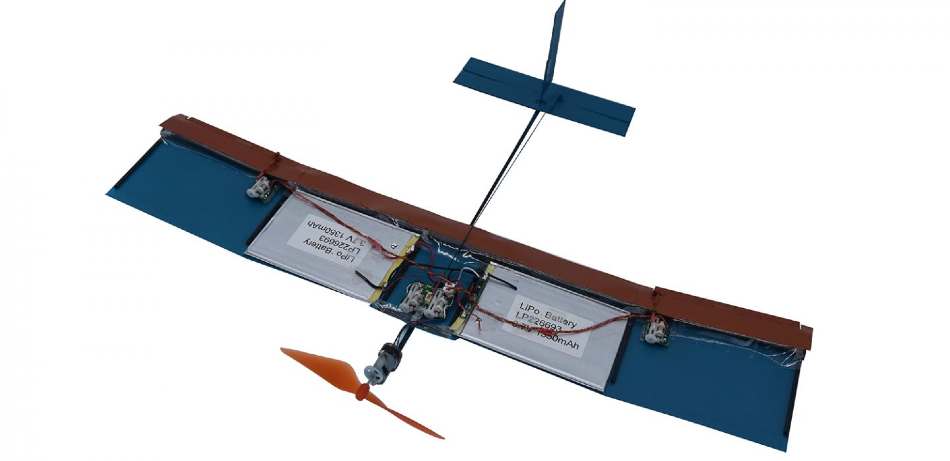Jan 30 2020
Thanks to a new kind of wing designed by Brown University researchers, small fixed-wing drones can now become much more efficient and stable.
 A new wing design could make small fixed-wing drones more stable and efficient. Image Credit: Breuer Lab/Brown University.
A new wing design could make small fixed-wing drones more stable and efficient. Image Credit: Breuer Lab/Brown University.
The new wing substitutes the smooth contour that occurs on the leading edges of a majority of the airplane wings with a sharp leading edge and a thick flat plate. Although the design might appear counterintuitive, it has been found to have unique aerodynamic advantages at the scale of small drones.
In a study reported in Science Robotics, the team demonstrates that the new wing is much more stable compared to conventional wings when it comes to sudden wind gusts and turbulence of other forms, which often cause great damage to small aircraft. In addition, the wing offers an aerodynamically efficient flight that in turn improves battery life and ensures longer flight times.
“Small drones can be really useful in many applications, including flights in populated areas as they are inherently safer for humans, but there are problems operating aircraft at those small scales,” said Kenny Breuer, a professor in Brown’s School of Engineering and the study’s senior author.
They tend to be inefficient, which limits the battery-powered flight times of most drones to around 30 minutes or so. They also tend to get blown around by puffs of wind and turbulent air coming from obstacles such as buildings and trees. So we’ve been thinking about a wing design that might combat those problems.
Kenny Breuer, Professor, School of Engineering, Brown University
The inspiration for the concept of a wing that dispenses with the smooth contours of the leading edge of a normal wing was derived from natural flyers such as insects and birds. Airflow can be kept firmly bound to the wing through a smooth leading edge
However, insect and bird wings often have very rough and sharp leading edges to advance separation of the airflow. Although flow separation leads to efficiency problems in the case of large aircraft, it has been observed to work well for insects and birds.
Animals at small scale don’t try to keep the flow attached. They gave up on that 100 million years ago. Once you stop trying to keep the flow constantly attached, it ironically makes some things easier.
Kenny Breuer, Professor, School of Engineering, Brown University
Named “Separated Flow Airfoil,” the new wing was engineered by Matteo Di Luca, the study’s lead author and a graduate student at Brown. The concept is to deliberately separate the flow at the leading edge, which slightly causes the flow to counterintuitively reattach more consistently before it reaches the trailing edge.
That reattachment is supported by a small rounded flap positioned close to the trailing edge of the wing. The design allows more stable, more efficient flight at the scale of aircraft, with wingspans of nearly a foot or less.
The design works due to the characteristics at small scales of the boundary layer, which is the thin layer of air that is in direct contact with the wing. In the passenger plane scale, the boundary layer is turbulent at all times—that is, it is full of tiny vortices and swirls.
It is precisely this turbulence that keeps the boundary layer against the wing, maintaining it firmly attached. But at small scales, the boundary layer is often laminar. A laminar boundary layer can easily separate from the wing and usually never reattaches, which results in reduced lift and increased drag.
The freestream turbulence further complicates things. This form of turbulence includes gusts of wind, vortices, and other disturbances in the surrounding air. Due to this freestream turbulence, there could be sudden turbulence in a boundary layer, which leads to the attachment of the flow and causes a sudden jolt of elevated lift. Quick fluctuations in the lift can be higher compared to what a drone’s control system can tackle, thus resulting in unstable flight.
The Separated Flow wing has the ability to address these problems.
When we purposefully separate the flow at the leading edge, we cause it to immediately become turbulent, which forces it to reattach at a consistent point regardless of atmospheric turbulence. That gives us more consistent lift and overall better performance.
Matteo Di Luca, Study Lead Author and Graduate Student, Brown University
When the Separated Flow Airfoil was tested in a wind tunnel, it was found that the design was successful in smoothing out lift fluctuations caused by freestream turbulence. The researchers also carried out wind tunnel tests of a small propeller-driven drone fitted with the Separated Flow wing.
Those tests demonstrated that the increased aerodynamic efficiency led to a reduced minimum cruise power than conventional miniature drones. This converts into longer battery life.
“With the prototype we have, we’re at a little less than 3 hours of flight time in the wind tunnel,” added Di Luca. “The wind tunnel is an idealized environment, so we don’t expect it would last quite that long for an outdoor flight. But if it lasts half as long as it did in the wind tunnel, it’s still more than twice the flight of commercially available drones.”
Apart from better aerodynamic performance, this design offers other benefits. The Separated Flow wing can be much thicker compared to wings that are usually used in small drones. This feature makes the wings structurally powerful, enabling subsystems such as solar panels, batteries, or antennas to be combined into the wing. This could minimize the size of an aerodynamically bulky fuselage—or totally avoided the need for one.
The team has obtained a patent on their design and intends to fine-tune it further for much better performance.
Stefano Mintchev, Yunxing Su, and Eric Shaw were the other co-authors of the study. The study was supported by the National Science Foundation (CMMI-1426338) and a Brown University Presidential Fellowship.